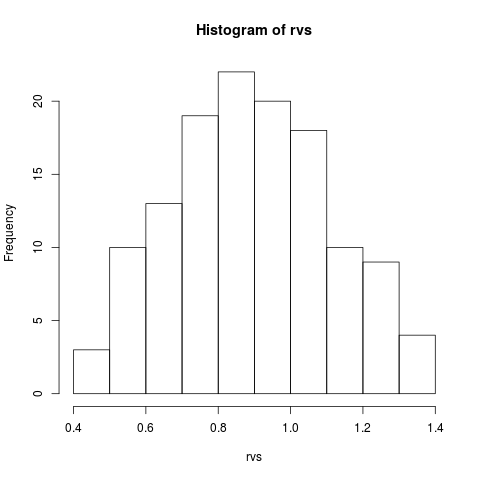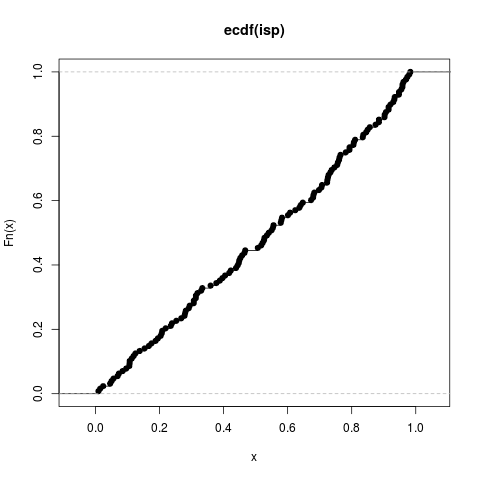Supported by Dr. Osamu Ogasawara and  providing providing  . . |
|
Last data update: 2014.03.03 |
The (non-central) maximal Sharpe ratio distribution.DescriptionDensity, distribution function, quantile function and random
generation for the maximal Sharpe ratio distribution with
Usagedsropt(x, df1, df2, zeta.s, ope, drag = 0, log = FALSE) psropt(q, df1, df2, zeta.s, ope, drag = 0, ...) qsropt(p, df1, df2, zeta.s, ope, drag = 0, ...) rsropt(n, df1, df2, zeta.s, ope, drag = 0, ...) Arguments
DetailsSuppose xi are n independent draws of a q-variate normal random variable with mean mu and covariance matrix Sigma. Let xbar be the (vector) sample mean, and S be the sample covariance matrix (using Bessel's correction). Let Z(w) = (w'xbar - c0)/sqrt(w'Sw) be the (sample) Sharpe ratio of the portfolio w, subject to risk free rate c0. Let w* be the solution to the portfolio optimization problem: max {Z(w) | 0 < w'Sw <= R^2}, with maximum value z* = Z(w*). Then w* = R S^-1 xbar / sqrt(xbar' S^-1 xbar) and z* = sqrt(xbar' S^-1 xbar) - c0/R The variable z* follows an Optimal Sharpe ratio distribution. For convenience, we may assume that the sample statistic has been annualized in the same manner as the Sharpe ratio, that is by multiplying by d, the number of observations per epoch. The Optimal Sharpe Ratio distribution is parametrized by the number of assets, q, the number of independent observations, n, the noncentrality parameter, zeta* = sqrt(mu' Sigma^-1 mu), the 'drag' term, c0/R, and the annualization factor, d. The drag term makes this a location family of distributions, and by default we assume it is zero. The parameters are encoded as follows:
Value
Invalid arguments will result in return value NoteThis is a thin wrapper on the Hotelling T-squared distribution, which is a wrapper on the F distribution. Author(s)Steven E. Pav shabbychef@gmail.com ReferencesKan, Raymond and Smith, Daniel R. "The Distribution of the Sample Minimum-Variance Frontier." Journal of Management Science 54, no. 7 (2008): 1364–1380. http://mansci.journal.informs.org/cgi/doi/10.1287/mnsc.1070.0852 See Also
F-distribution functions, Other sropt: Examples# generate some variates ngen <- 128 ope <- 253 df1 <- 8 df2 <- ope * 10 drag <- 0 # sample rvs <- rsropt(ngen, df1, df2, drag, ope) hist(rvs) # these should be uniform: isp <- psropt(rvs, df1, df2, drag, ope) plot(ecdf(isp)) Results
R version 3.3.1 (2016-06-21) -- "Bug in Your Hair"
Copyright (C) 2016 The R Foundation for Statistical Computing
Platform: x86_64-pc-linux-gnu (64-bit)
R is free software and comes with ABSOLUTELY NO WARRANTY.
You are welcome to redistribute it under certain conditions.
Type 'license()' or 'licence()' for distribution details.
R is a collaborative project with many contributors.
Type 'contributors()' for more information and
'citation()' on how to cite R or R packages in publications.
Type 'demo()' for some demos, 'help()' for on-line help, or
'help.start()' for an HTML browser interface to help.
Type 'q()' to quit R.
> library(SharpeR)
Attaching package: 'SharpeR'
The following object is masked from 'package:base':
summary
> png(filename="/home/ddbj/snapshot/RGM3/R_CC/result/SharpeR/dsropt.Rd_%03d_medium.png", width=480, height=480)
> ### Name: dsropt
> ### Title: The (non-central) maximal Sharpe ratio distribution.
> ### Aliases: dsropt psropt qsropt rsropt
> ### Keywords: distribution
>
> ### ** Examples
>
> # generate some variates
> ngen <- 128
> ope <- 253
> df1 <- 8
> df2 <- ope * 10
> drag <- 0
> # sample
> rvs <- rsropt(ngen, df1, df2, drag, ope)
> hist(rvs)
> # these should be uniform:
> isp <- psropt(rvs, df1, df2, drag, ope)
> plot(ecdf(isp))
>
>
>
>
>
>
> dev.off()
null device
1
>
|

